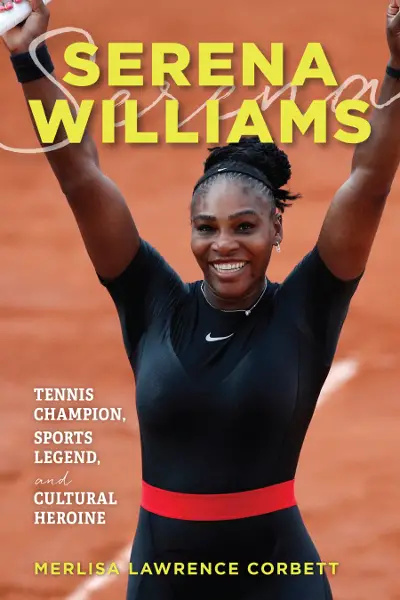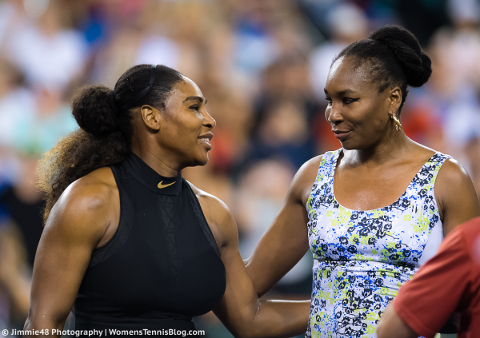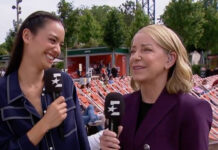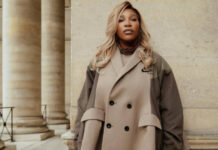A new biography is out, entitled “Serena Williams: Tennis Champion, Sports Legend, and Cultural Heroine,” written by Merlisa Lawrence Corbett, a tennis columnist and veteran sports journalist whose work has appeared in Bleacher Report, TennisView, Yahoo Sports, and London-based TennisLive.com, while she is also a former reporter for Sports Illustrated. Merlisa approached me to tell me about her book and suggested that I share two excerpts, one about Serena’s unapologetic development into a tennis fashion icon and one about her relationship with sister Venus.

Fashion Forward (Chapter 7)
Serena’s first serious foray into the fashion industry began in 1998, when she signed a $12 million endorsement contract with German sneaker maker Puma. At the time, Puma was taking a chance on a player who had yet to crack the Top 100 or win a WTA title. The collaboration with Puma would produce some of Serena’s most memorable outfits and catapult her from fresh-faced teen to fashionista. Although short-lived, the Puma years helped Serena transition from ghetto princess to “glam slammer.”
When Serena won the 1999 US Open, she wore a basic yellow and white Puma dress. She was only 17 and still wore beads. Her earliest Puma outfits were bland and looked like any other tennis dresses. But after she turned 18, her kits became a bit more daring, like the tie-dyed lavender and purple skirt she wore in 2000, at the Summer Olympics and the US Open. However, it was in about 2002, the year Serena turned 21, that her on-court attire took a turn for the fierce. At the 2002 French Open, Serena wore a metallic pewter-colored dress with yellow trim. It looked more like something a 21-year-old might wear to a nightclub. Still, that outfit would soon be forgotten.
The 2002 US Open marked the first time Serena entered a Grand Slam ranked number one. She had three Grand Slams titles under her belt and was establishing herself as a dominant force on the WTA Tour. She was also capitalizing on her growing fame at a time when reality television was creating overnight sensations. That year, American Idol debuted in the United States. While Kelly Clarkson sang her way to superstardom, Serena slayed her way into tennis and fashion history.
It was at the 2002 US Open that Serena wore the “catsuit,” a black faux-leather jumpsuit that hugged every curve on her body. Along with her blond braids in a ponytail, Serena’s look was perfect for the New York nights at Flushing Meadows.
Puma allowed Serena to have substantial input into her designs. This included the
infamous catsuit. Serena wrote in “On the Line”:
What most people didn’t realize was it was so comfortable! Of course, that catsuit was so hot I would have worn it even if it was the most uncomfortable thing in the world, but it was designed with performance in mind.
Outrageous but stylish, the catsuit remains one of the most-talked about kits in tennis history. A replica of the catsuit was even on display at the Museum of Applied Arts and Sciences exhibit in 2003. Off the court, like many women in their early 20s, Serena wore edgy, racy, and fun outfits. She seemed to be embracing her role as a celebrity when she rocked the red carpet at the 2003 ESPN ESPYs wearing a severely low-cut, light magenta gown with a leg’s-length slit up the front.
The Puma years expired in 2003, when Serena signed a reported $55 million deal with Nike. After she signed with Nike, she became a backhand swinging, walking billboard for sportswear. During Grand Slams, when Serena shed her warm-up jacket to reveal her latest look, it was like a New York fashion week preview.
Meanwhile, she capitalized on her newfound status as a fashionista. In 2003, she launched a clothing line called Aneres, Serena spelled backward. It was her first attempt at a career in fashion design. Serena premiered her Aneres clothing collection in December 2004. Despite publicity, the line flopped. Serena said:
Everyone that goes to fashion school wants to do eveningwear… I stuck with that for years and years, and I loved it. But I was doing evening gowns, and we never actually sold anything—nothing that people could really actually buy in store… So many times I would be at a meeting with Macy’s or lots of other companies, and they would be like, ‘We love it. We love the presentation, but we’re not going to get this collection.’ I’ve sat through so many of those meetings, more than I can count to be honest. And they’re
demoralizing.
So, it was back to focusing on tennis and collaborating with Nike to express her fashion fixation. Topping the catsuit would not be easy, but Serena came close with a provocative urban cowgirl kit she wore at the 2004 US Open. With studded details and footwear that looked like biker boots, that outfit is second only to the catsuit in terms of outrageousness.
Her style gained as much attention as her play, and sometimes the publicity was not all good. Some in the tennis world viewed her fashion pursuits as flighty, an unnecessary distraction. They saw her abundance in talent and athletic gifts as attributes that tethered her to tennis. Industry experts pressured Serena to pick one, fashion or tennis. None of this mattered to Serena. She pursued her fashion passions both on and off the court despite the critics. When Serena wanted to showcase a new Nike outfit she helped design for her run at the 2005 Australian Open, some journalists were less than kind. Leading up to the tournament, the Telegraph’s Mark Hodgkinson blasted Serena for her “poor taste.” He wrote,
With a fashion show at a hotel in St Kilda, an edgy part of town that distrusts the mainstream, Williams showed off her lime-green-and-white Nike boots with her usual theatricality, ignoring the disparaging comments from the list’s author that she has moved ‘from queen of tennis to female fashion menace.’ However, it is increasingly difficult to know where her priorities lie. As a tennis player? As a fashionista?
Hodgkinson went on to hint that Serena’s desire for a future in fashion could mean that 2005 would be the last year fans saw Serena in a tennis skirt. He even mocked Serena for being ranked number five on a worst dressed list, one spot higher than her WTA ranking.
Hodgkinson’s story ran under the headline, “Serena: From Queen of Tennis to Fashion Menace.” Coincidently, the year Hodgkinson wrote the story criticizing Serena’s fashion sense, she went on to win the Australian Open while wearing her lime-green boots. Serena continued to ignore critics. She appeared to relish her role as fashion ambassador. Similar to her aggressive nature on the court, she took risks and bucked the status quo. Dr. Delia Douglas said:
She wears what she wears and embraces her body. With respect to her embodiment and comfort, she’s like, ‘I’m a black woman and this is what I look like. This is the body I have, and I’m living the life.
Sisterly Love (Chapter 3)

Serena worshipped Venus; however, Serena wrote about feeling inadequate when compared to Venus when they were kids. She thought Venus was prettier, skinnier, and more confident. Mostly, however, Serena grew up in awe of her older sister and insisted on accomplishing all of Venus’s achievements.
After Venus began entering tournaments, Serena was eager to follow suit. But like many younger siblings, Serena had to wait her turn. “Not yet Meeka. You’re not ready,” she recalled her father saying. That didn’t stop an enterprising eight-year-old from entering herself in a tournament, without her parent’s knowledge. It was a 10-under tournament in the Los Angeles area before they moved to Florida. Because she usually brought her racket along when traveling to Venus’s events, no one suspected that she was in the competition. She was even smart enough to check the draw without giving herself away.
I didn’t think I was doing anything wrong. I just wanted what Venus had. That was all I ever wanted, to be just like Venus—my role model, then and still—so I went out and took my turn like I had it coming.
That would be the first time the Williams sisters faced off in a tournament. After her parents got over the initial shock, they grew excited as they realized their daughters would meet in the final. Serena remembers her parents feeling torn about who to root for and deciding they just wanted both girls to play well.
More than a biography, “Serena Williams: Tennis Champion, Sports Legend, and Cultural Heroine” not only tells the story of her upbringing and remarkable career but also looks at Williams as a sports pioneer. Merlisa Lawrence Corbett explores Williams’ influence on cultural and political issues such as body shaming, gender equality, and racism in sports and society. Corbett also analyzes Williams’ impact on discussions of feminism, the sports celebrity, and the marketing of female athletes. Williams is one of the most intriguing and influential figures in sports, and this book is the first to provide a fully-rounded portrait of a tennis icon.




